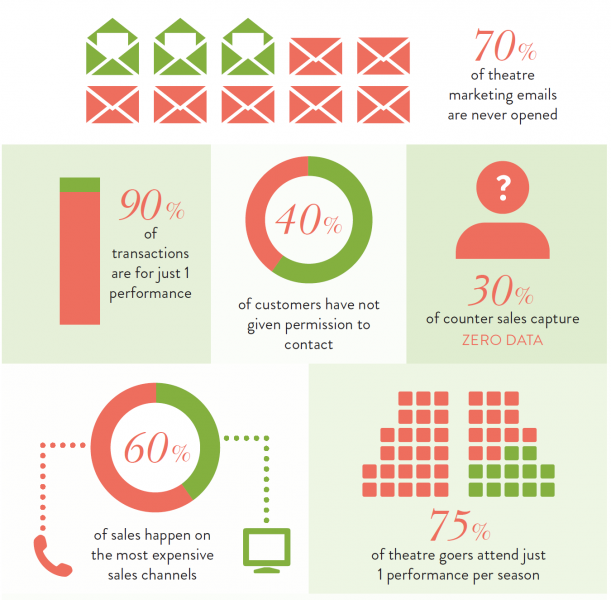
Art’s labour’s lost
Despite decades of investment in audience development and the current enthusiasm for all things data, arts organisations still aren’t getting it, says Michael Nabarro.
What would you say to a friend who continually made the same error over and over again? Imagine you’d watched for years as they fell stubbornly into the same trap; month in, month out.
In 2015 that’s the situation too many arts organisations find themselves in: working hard to address chronic marketing and fundraising challenges, but stubbornly resisting changes that support audience development and deepen customer relationships.
If that sounds like a sweeping generalisation, consider the results of our 2014 aggregate data study of the arts industry. Looking at over 10 million transactions and a billion web hits across 144 UK arts organisations, a frustrating picture emerges of opportunities repeatedly lost and chances continually missed.
Let’s start with our industry’s grudging inability to cross-promote its products. More than 90% purchased last year were for a single performance. Whether it’s down to poor technology, lack of training or discomfort with active selling, it helps explain why nearly 75% of theatregoers in 2014 attended just once the entire year.
This is especially troubling given that a version of Pareto’s Principle applies to arts marketing as well – the 27% of customers attending two or more performances annually drive half our revenue. Drilling down a bit further, the 13% of customers who attend three performances or more account for 32% of revenue. As it’s half as expensive to keep a current customer as it is to find a new one, we clearly spend too much time chasing individuals who buy only once.
Another problem is where and how those sales are taking place. With more than 55% of tickets last year sold on the phone or at the counter, it’s clear we have not grasped how to move customers over to online purchase – the least expensive channel available.
This is not to suggest that you’d want 100% of purchases to happen online. A certain amount of personal communication is absolutely necessary to promote audience engagement and re-attendance. But we aren’t getting that right either. Nearly 30% of counter sales in 2014 captured no data about the customer, i.e. we spoke with and sold tickets to a whopping number of people, without the complete picture of their attendance history, or in some cases even basics like contact information.

But look at what happens when we do create proper customer profiles, and capture full contact details.
40% of the customers in UK arts databases have not given their permission to be contacted. That’s tens of thousands of people who we know want our products, but who we are barred by law from marketing ourselves to.
It’s not as if we can rest on the effectiveness of our direct marketing campaigns. More than 70% of arts marketing emails go straight to the delete bin un-opened. Whilst a 30% open rate is actually very good when compared to other sectors, it just isn’t powerful enough to overcome the other opportunities we’re missing.
So what can you do?
In 2015 an effective audience growth strategy rests on good data and the willingness of staff to use it proactively to engage with customers. If your customer information is poor or difficult to access, the whole exercise becomes rather pointless. The same is true of attitudes and behaviours that stop us from becoming commercially minded. Organisational change is a big topic and arts organisations are clearly still adjusting to the realities of austerity. Yet in the short term there are practical operational fixes that can help you break out of the audience development doldrums.
Up selling, cross selling and asking for donations can all be done effectively and less expensively online, so thinking of your website as an extension of the box office team is important.
Recognise that audience members are not all the same. Split the audience into segments with shared interests and needs, then tailor your offers and communications to the preferences and behaviours of each group.
To improve retention and re-attendance, make sure you can create a customer segment on your system for people who attended last year but haven’t yet booked in the current season.
Improving the effectiveness of email marketing campaigns will always be a challenge but the goal has to be a 100% open rate. Take an iterative approach by measuring the open rates for different messages, segments and types of content used.
Convincing customers to let you send them marketing messages can be tricky, but asking is your starting point. Staff need to be trained to ask for email opt-in at every opportunity.
The best way to grow and sustain audiences is to drive re-attendance in the form of frequency and loyalty. Being able to communicate with people who have actually been in our buildings is a baseline requirement, and in the current funding environment, arts organisations just can’t afford to let revenue opportunities slip away.
Michael Nabarro is Co-Founder and CEO of Spektrix.
www.spektrix.com
You can download the full 2014 Arts Industry Data Study at here.
Join the Discussion
You must be logged in to post a comment.